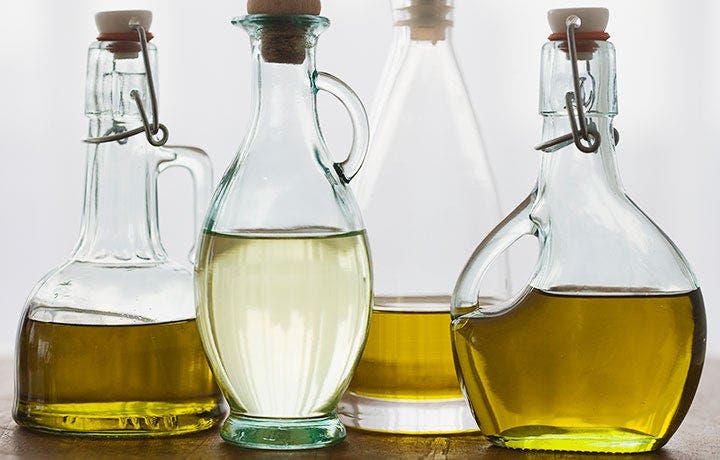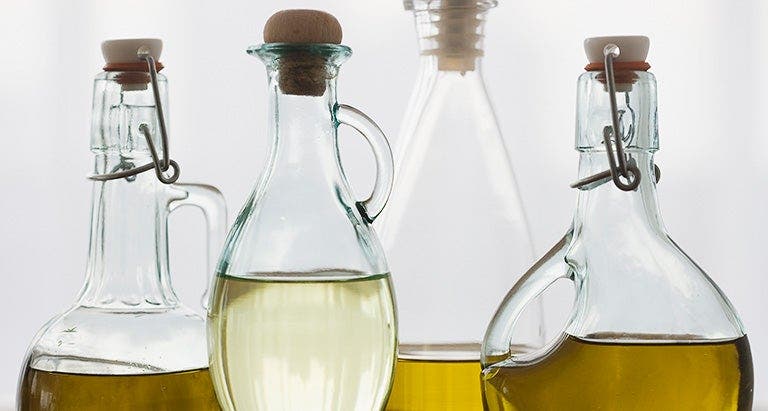The Skinny on Oil


First things first: oil isn’t the enemy of healthy eating. Contrary to conventional wisdom, oils (which contain about 120 calories per tablespoon) are actually essential for proper body and brain function, and are essential for helping the body absorb vitamins A,D,E and K. Equally important, they help impart depth to your favorite dishes and “carry” the flavors you’ve chosen to put into a recipe.
Still, confusion reigns supreme about which oils are best to keep in your kitchen rotation; the difference between “good” and “bad” fats, and the proper uses for a variety of oils. Here, all of the information you’ll need.
A Primer on Fats
Fats are complex natural chemical compounds, and the way in which a fat’s carbon and hydrogen atoms are bonded is what determines whether it is classified as saturated, monounsaturated or polyunsaturated.
Saturated fats
Typically from animal sources—butter and lard are two examples—and typically believed to raise cholesterol. For the most part, these should be avoided or used in moderation. “People should try to get as little oil from animals and as much from plant-derived sources as possible,” says Julie Negrin, M.S., a certified Nutritionist and Culinary Educator based in Seattle, WA.
Monounsaturated fats
Think olive oil, canola oil, peanut oil, avocado oil and sesame oil (see the sidebar), all of which actually help lower bad-cholesterol, or LDL. Of these, canola and olive oils should be the building blocks of your pantry. Olive oil, besides being delicious, contains Vitamin E and polyphenols, both of which are believed to help prevent cancer and heart disease. Canola also has the added benefit of containing Omega-3 fatty acids, which may promote heart health.
Polyunsaturated fats
Corn, cottonseed, safflower, soybean, sunflower, walnut and pumpkin oils are some examples. While these fats do not necessarily lower LDL (the so-called “bad cholesterol”) they don’t raise it either, and can still contribute toward good health.
RELATED: Good Fats v Bad Fats
Know Your Oil's Smoke Point
Once oil reaches its smoke point (meaning it begins to break down at high heat) it’s no longer adequate for cooking, and loses most of its positive health attributes. While many oils—among them avocado, light olive and peanut—have high smoke points, canola has proven a popular choice since it’s flavor-neutral, inexpensive and easy to find. Corn and peanut oils also fare well at high temperatures, just make sure to account for their subtle flavor.
To be sure oil doesn’t reach its smoke point, keep an eye on it—if your pan is smoking and oil appears to be thinning dramatically, it’s time to lower the heat. Here are the smoke points for some common oils:
- Avocado oil: 271°C and 520°F
- Canola oil: 200°C and 400°F
- Coconut oil: 177°C and 350°F
- Extra Virgin Olive oil: 160°C and 320°F
- Grapeseed oil: 216°C and 420°F
- Palm oil: 232°C and 450°F
- Peanut oil: 227°C and 440°F
- Sesame oil: 210°C and 410°F
- Virgin Olive oil: 216°C and 420°F
Best Oils for Baking
If you have one oil on hand for baking, make it canola, but experiment with substituting light olive oil in recipes for quick breads and muffins. Use olive oil in Mediterranean recipes such as focaccia or pizza dough. For cookies, avoid trans fat-laden hydrogenated oils (shortening, margarine) and instead opt for canola oil or a combination of oil and a little melted butter. Corn oil works in cornbreads and some other recipes as well, though it has a slightly heavier flavor profile.
RELATED: 22 Cake and Cookie Recipes
How to Store Cooking Oils
Keep oil in a cool, dry place, away from direct sunlight. Fragile nut oils should be stored in the refrigerator, then removed one hour before use to restore their viscosity. Some better olive oils come wrapped in silver or gold foil—don’t remove this covering, as it’s designed to help protect the oils from the elements. Oils should be used within two months of opening. When in doubt, sniff oil before using and if it smells stale or rancid, throw it out.
Using Oil to Finish a Dish
When you want maximum flavor bang for the buck, opt for finishing oils—just a drizzle right before eating drums up big taste results. Some oils that can be used in this manner are:
Extra Virgin Olive Oil: Flavors run the gamut from grassy and peppery to floral and bitter. Invest in a top-quality bottle (ask your gourmet shopkeeper to help you pick one). Drizzle on roasted veggies, pastas and ripe tomatoes.
Nut Oils: With their low smoke points, delicate nut oils (pumpkin seed, walnut, hazelnut) are great for anointing dishes just before serving. Many are high in phytonutrients, which may help control skin- and heart-damaging free radicals.
Roasted Sesame Oil: Dark-brown, toasty, nutty. Drizzle on Asian food, grilled meats and stir-fries.
Truffle Oil: Rich, earthy, decadent. Unless you’re spending serious money, it’s probably a neutral oil, such as sunflower, flavored with natural or artificial truffle essence.
Flaxseed Oil: Nature’s secret weapon. Nutty-tasting and full of Omega-3s, flaxseed oil contains alpha-linolenic acid, which can turn into omega 3 fatty acid in the body. Very fragile and delicate, it usually comes in a dark bottle, must be stored in the refrigerator, and can be used in salad dressings, or drizzled on steamed vegetables.
Flavored Oils: Bottles of oil infused with garlic, rosemary or chili peppers can be attractive and flavorful, but we recommend you avoid them. The moisture in the added flavorings can cause botulism when mixed with oil. Instead, make instant flavored oils by mashing a garlic clove or seeded chili pepper directly into oil, then drain out the solids and use immediately.
RELATED: The Skinny on...Nuts and Seeds
